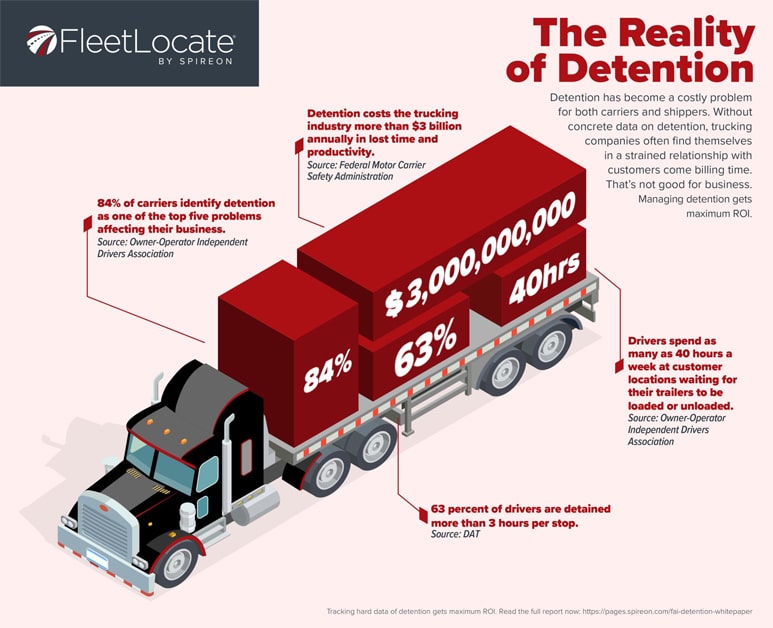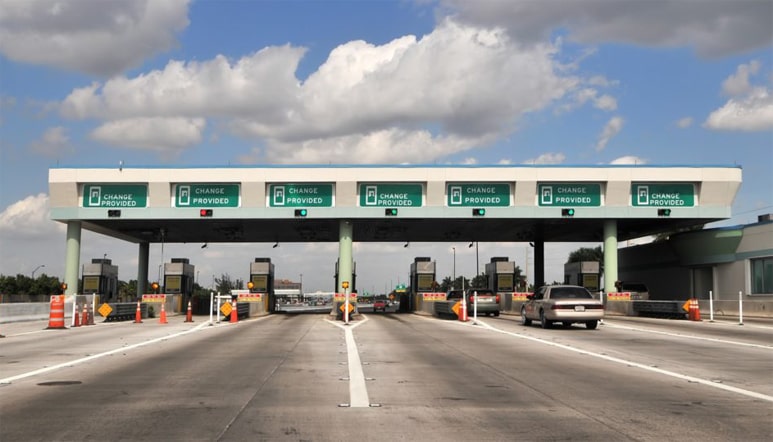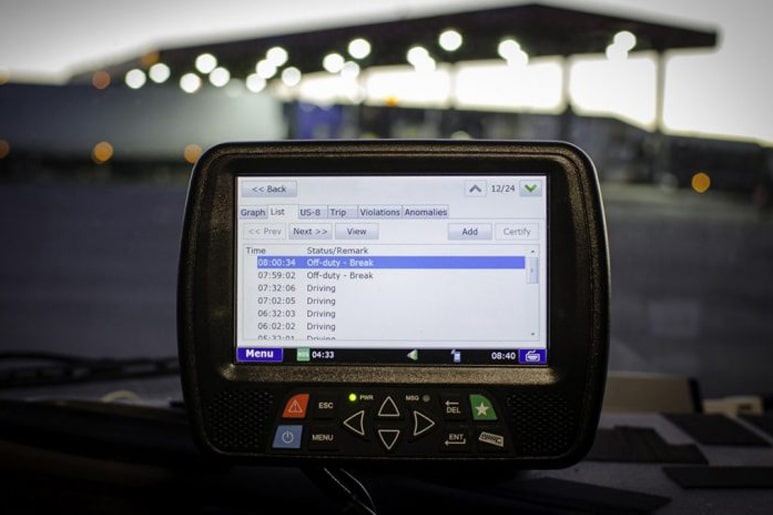Driving a truck for a living has never been easy.
Like every other profession, it has its own best moments and also difficulties.
Some of the problems are out of the companies’ reach and drivers are facing them on their own.
Table of Contents
- Driver Shortage
- Hours of service (HOS)
- Detention and delay at customer facilities
- Health problems
- Lack of sleep
- Lack of home time
- Truck parking
- Deficient infrastructure
- Expensive tolls
- Electronic logging devices mandate
- No meteorological data
- Conclusion
1. Driver Shortage
The talk about that there is not enough professional truck driving workforce is something that we hear on a daily basis.
There are various reasons causing this problem. You may want to see our infographic about truck driver shortage causes to learn more.
Some of them are the lack of qualified drivers, more than 26% of truckers are aged 55 years and older, unsatisfactory working conditions, low pay, new and tougher driver regulations, drug tests and policy, not enough home time etc.
The driver shortage affects the entire economy.
Many of the products and services that are used come from the long hours and miles that truck drivers put in.

So what can be done to solve this shortage?
The trucking industry needs to bring in new, young drivers and retain the drivers it currently has. The regulated drivers age needs to be lowered and to engage more 18-21 aged people to gain a CDL (commercial driver’s license). Female and minority drivers make up a small percentage, but it can benefit the industry in a great way.
Most carriers have been offering pay increases and comprehensive benefits packages so they can motivate the drivers.
Something that every driver looks for is less time on the road and more time at home, so with this change by keeping the truckers more localized this profession can become more and more desirable.
The drivers needs to be equipped with technology that helps them do their job more efficiently, leading to higher job satisfaction.
With correct logistics transportation optimization, the empty miles will be reduced and routes are going to be more efficient.
2. Hours of Service (HOS)

Hours of service is the maximum amount of time drivers are permitted to be on duty including driving time, and specify number and length of rest periods, to help ensure that drivers stay awake and alert on the road.
Summary of Hours of Service Regulations:
- 11-Hour Driving Limit: “May drive a maximum of 11 hours after 10 consecutive hours off duty.”
- 14-Hour Limit: “May not drive beyond the 14th consecutive hour after coming on duty, following 10 consecutive hours off duty. Off-duty time does not extend the 14-hour period.”
- 30-Minute Driving Break: “Drivers must take a 30-minute break when they have driven for a period of 8 cumulative hours without at least a 30-minute interruption.”
- 60/70-Hour Limit: “May not drive after 60/70 hours on duty in 7/8 consecutive days. A driver may restart a 7/8 consecutive day period after taking 34 or more consecutive hours off duty.”
- Sleeper berth provision: “Drivers must take at least eight consecutive hours in the sleeper berth, plus a separate two consecutive hours either in the sleeper berth, off duty, or any combination of the two.”
3. Detention and Delay at Customer Facilities
Delays experienced by truck drivers at customer facilities have increased over the past years.
Driver detention is when a driver’s route is delayed at the origin pick up, or the destination delivery location for more than the agreed time.
Usually after 2 hours, the carrier will request a detention fee for the delay.

The purpose of the charges is to compensate the driver`s lost hours, which can result in running out of legal driving hours, unavailability to transport the goods from origin to destination in timely manner or the driver may miss his next pick up and lose his next load.
The cost of the fees varies based on the company, the equipment, and the geography.
The best ways for this problem to be avoided are:
- Optimizing the scheduling process.
- Making sure drivers are on-time.
- Advising the warehouse that the truck must be loaded within a given timeline such as 2 hours or less.
- Owning the proper equipment to unload the truck properly.
- Facility limitations can create backlogs of vehicles needing to be loaded or unloaded.
- Shippers can schedule carriers to arrive every 30 minutes, with a goal of having the carrier either loaded or unloaded within 90 minutes.
- A TMS can measure and analyze detention issues to find out where they occur and help implement procedures to reduce them.
Research shows that detention times have a negative impact on driver productivity, and have been known to influence the crash risk of drivers.
4. Health Problems

Due to an unhealthy lifestyle and lack of good nutritional options while traveling, truck drivers are categorically one of the unhealthiest population.
The food and lifestyle of a truck driver is mostly around store-bought goods and ready-to-consume food and drinks.
Some of the most common health issues drivers are facing in the trucking industry are:
1. Obesity
Being on the same posture for most of the time can cause affect on the overall body metabolism. These factors include high triglyceride levels, low HDL cholesterol levels, high blood pressure, high fasting blood sugar and a larger waistline. Obesity can cause additional health concerns such as type 2 diabetes, sleeping disorders, and heart diseases.
Making healthy habits is crucial in keeping the overall health. Meal planning is an easy method to reduce the desire to stop for fast food, so always make sure there are fruit and vegetables in the truck, include whole grain foods, avoid drinks with sugar, and spend at least 15 minutes exercising.
2. Musculoskeletal problems
These include back and shoulder pain, arthritis and more. Also, the injuries caused by loading and unloading the trucks are not excluded. Prolonged sitting increases the risk of deep vein thrombosis, which happens when a blood clot forms in a deep vein.
Implement exercising into the daily routine to loosen the body can prevent stiffness. Drivers need to adjust their seat or to put a rolled towel on the small of your back that provides lumbar support. A towel or small pillow placed behind the neck can add support. The seat height, seat back inclines and distance from pedals conforms to ideal positioning.
3. Lung Cancer
More than 70% of truck drivers are smokers. They are also exposed to gasoline fumes and similar chemicals.
To lower the chances of lung cancer, give up smoking and check the ventilation systems to ensure that they are properly working. The stress can be relieved with some different methods other that smoking. Never allow other people to smoke in the cabin.
4. Obstructive Sleep Apnea
This sleeping disorder causes someone’s breathing to stop periodically while they’re asleep. This can lead for them to be having slow reaction times when they’re awake. Truck drivers are screened for sleep apnea as part of their CDL physical, and sometimes truckers with sleep apnea are not allowed to drive until the problem is corrected.
Use of CPAP (continuous positive airway pressure) devices for sleep apnea usually reduces or normalizes these risks.
5. Stress
In the trucking industry, there is stress in every angle of everyday job. There is stress associated with making deliveries on time, being stuck in traffic and dealing with bad drivers on the road. However, stress can also be caused by lack of sleep, isolation, and other health concerns.
This sleeping disorder causes someone’s breathing to stop periodically while they’re asleep. This can lead for them to be having slow reaction times when they’re awake. Truck drivers are screened for sleep apnea as part of their CDL physical, and sometimes truckers with sleep apnea are not allowed to drive until the problem is corrected.
Use of CPAP (continuous positive airway pressure) devices for sleep apnea usually reduces or normalizes these risks.
6. Hypertension
High blood pressure is referred to as “hypertension”. High blood pressure will often not show any symptoms for years. The common symptoms are: shortness of breath, vision changes, nose bleed, irregular heartbeat, pounding in the ears or chest.
Truck drivers are subject to medical examinations, which electronically will share the blood pressure numbers with the DOT. There are three classes of hypertension medical certifications:
- Blood Pressure 140/90-150/99 – Known as stage one hypertension, drivers with blood pressure within this range will be issued a three-month non-renewable certification in which they must get their blood pressure under 140 or be disqualified from driving.
- Blood Pressure 160/100-179/109 – Known as stage two hypertension, those with blood pressure within this range are issued a three-month certification, and must bring their blood pressure down either with or without medication to fewer than 140 or are disqualified from driving.
- Blood Pressure 180/110+ – Known as stage three hypertension, drivers with blood pressure numbers within this range are automatically disqualified from driving, and if they can get their blood pressure down below 140/90 they can be issued a six-month medical certification and be required to re-certify every six months.
7. Dehydration
Not consuming enough water may cause drivers to face dehydration. Many truckers don’t drink enough water because they don’t want to stop for frequent bathroom breaks. When we are dehydrated, our brain function becomes reserved. This can lead to issues that impact mental clarity, reaction time, muscle function, and even our mood. Dehydration also affects the blood volume causing headaches and dizziness. And while there’s no evidence that caffeinated drinks cause dehydration, they can be a mild diuretic in large amounts. Also, while the A/C may feel good, that cool breeze sucks moisture from the air and your body.
Signs of mild dehydration include: dry and sticky mouth, sleepiness, dry skin, dizziness.
Proper hydration is vital for driver health and for safety, so that`s why drivers need to be informed on the importance of hydration and the symptoms of dehydration.
How can the drivers stay hydrated?
Always keep a bottle of water; eat water-rich foods like cucumbers, watermelon, celery, strawberry, iceberg lettuce etc. ; replace sugary sodas with sparkling water ; reduce the high-sodium foods.
5. Lack of Sleep

It’s not uncommon for commercial drivers to spend long periods of time driving. Driving late at night, driving a large number of miles, and driving for three or more hours at once are all factors that contribute to sleep deprivation.
Further reading: 10 tips to keep yourself awake on the road.
How lack of sleep affects the driving?
Drivers are easily distracted, they are thinking about everything except driving, which makes it harder to respond quickly in pressing the brakes or changing lanes, driving makes them more sleepy because the road is monotonous, the reaction time is slow which increases the risk for having a bad accident.
“Driving with less than the recommended eight hours of sleep each night is equivalent to driving with an alcohol blood content level of 0.10.”
What can be done when the sleepiness occurs?
Plan the trip and find time to sleep.
It’s much better to take a short break to rest the eyes and take a nap if possible than to keep pushing and end up having an accident.
Improve the conditions in the sleeping area to make it more comfortable.
Avoid having drinks full of caffeine, because after consuming caffeine because the sleep is not quality.
Take a walk because it relives the stress.
6. Lack of Home Time

Truck drivers spend a lot of time away from home.
They miss out on family events, children’s birthdays, and spending time with their friends. Being gone from home for days or weeks, can cause homesickness.
Technology and business developments have made it possible for truck drivers to stay connected to family and combat the loneliness of the open road.
Staying connected to family allows truck drivers to make them feel closer to home.
Learning how to balance work and life is key for truck drivers who want to be a trucker for life.
In some cases, truckers find the best solution to maintaining a great work-life balance is to bring their family with them on the road.
That’s the easier way to spend time together and share new experiences.
7. Truck Parking
Truck parking continuously is one of the main problems truck drivers face.
Not able to find an available truck parking can create dangerous situations for vehicle operators, forcing them to drive beyond the mandatory HOS down time in search of a location to park.

With traditional truck and rest stops filling up quickly, truckers find themselves now parking in abandoned parking lot on highways, and other dangerous locations.
Paying overnight fees or wasting the gas getting to a truck stop to spend the night is not the ideal situation for drivers.
There are free apps that can be downloaded on the phone and help find truck parking:
1. Park my Truck
- Android : https://play.google.com/store/apps/details?id=com.natso.availableparking&hl=en_US&gl=US
- Apple: https://apps.apple.com/us/app/park-my-truck/id1078688452
2. Trucker Path
- Android: https://play.google.com/store/apps/details?id=com.sixdays.truckerpath&hl=en_US&gl=US
- Apple: https://apps.apple.com/us/app/trucker-path-truck-gps-maps/id782746890
3. Truckbubba
4. Road Breakers
Don’t miss out: The Best Truck Stops in the US
8. Deficient infrastructure

Not only the truck drivers want to see improvements in the public roadways: better infrastructure, less congestion, and so on. Everyone included in the motorways is facing this problem.
The ATA says that the cost in wasted time is 141 million hours by freight truck industry.
Local and city roads that need pothole repair, resurfacing and leveling are costing truckers a lot of extra money in additional vehicle operating costs such as fuel consumption, tire wear, and deterioration.
With this poor conditions on the roads and extra expenses for maintenance, it`s not a surprise why a driver shortage is being faced.
9. Expensive tolls

Highway tolls are an expensive thing for any owner-operator or truck driver in the United States.
We already covered this topic in our previous article Essential Toll Road Guidelines For Truckers.
Toll charges average around $2500 per year for truckers.
Different states have different price so that`s why every trucker needs to be prepared for the road, so they won’t face any unpleasant surprises at toll crossings.
10. Electronic Logging Devices Mandate

An Electronic Logging Device is a piece of electronic hardware attached to a commercial motor vehicle engine to record driving hours. The driving hours of commercial drivers are typically regulated by a set of rules known as the hours of service in the United States.
It is intended to help create a safer work environment for drivers, and make it easier and faster to accurately track, manage, and share records of duty status (RODS) data.
So why this became a problem for the truck drivers?
ELDs can present a significant cost for both independent drivers and small trucking companies.
It may force a decrease in driving hours and hurt driver productivity.
One driver stated, “I will have no choice but to drive in traffic, adverse weather conditions, and/or while fatigued because I can’t take a nap … because the clock is tick, tick, ticking away.”
11. No Meteorological Data

Professional truck drivers experience range of severe weather conditions.
It happens quite often for truckers to drive straight through a blizzard in the mountains right into dry, warm places all in one day.
Bad weather can cause inconvenience, delays, major accidents, interstate shutdowns.
Truck drivers need to know how to deal with bad weather conditions.
When there is a freezing rain, it`s best to find a safe place to exit the road and park until conditions improve. If the weather forecast predicts heavy snow, the tire chains have to be onboard.
The strong crosswinds can be powerful enough to blow a truck off the road. In this kind of weather is better to stop. Also the strong winds combined with snow, can cause an extreme icy road.
When travelling to Arizona, the wind storms are a most common thing. The drivers need to be aware of the weather coming in their way in order to prepare for it. Dust storms are sometimes hard to predict, so if one occurs is best to pull over and wait for it to pass.
Heavy hail storm can affect the visibility and it also can result in damage of the windshield of the truck.
High temperatures can literally melt the rubber from the tires. There is also a possibility of overheating the truck engine. If the truck engine goes in extreme high heat, it can cause serious motor damage.
One of the worst experiences is facing a tornado during the drive.
Driving in fog can be a tricky part of the job. If the visibility starts to decline, it`s better to find a spot to stop.
Conclusion
The trucking industry is strong and provides essential service and is expected to overcome these challenges with foresight, planning and determination.
As a truck driver, have ever faced a problem other than above mentioned?
Feel free to drop your line below.



